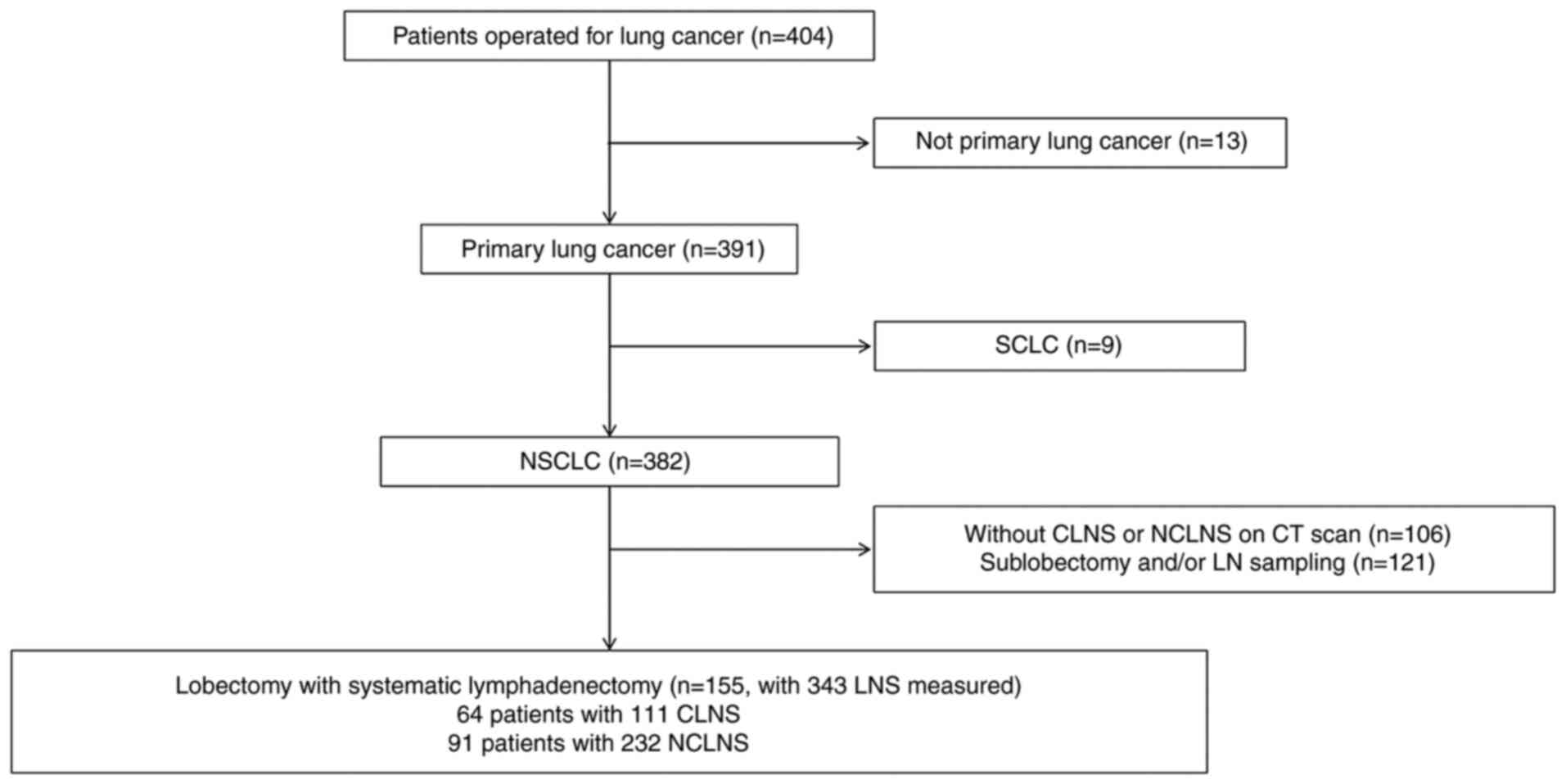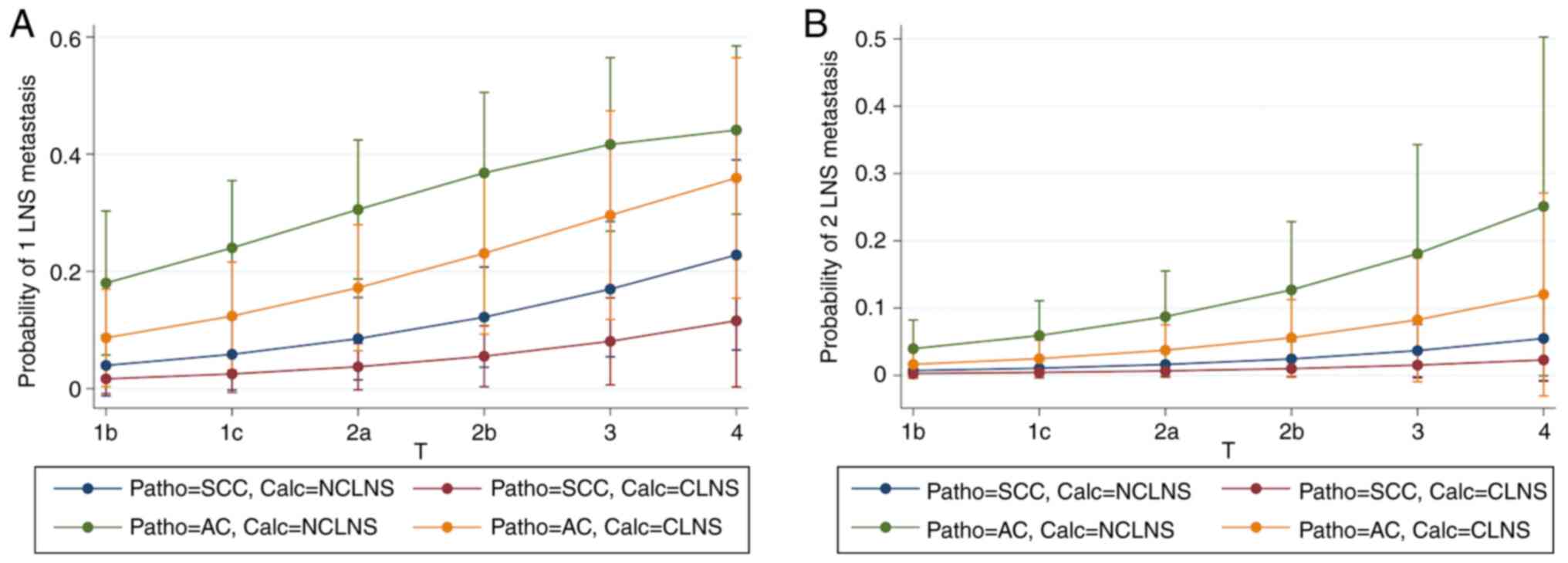|
1
|
Bille A, Woo KM, Ahmad U, Rizk NP and
Jones DR: Incidence of occult pN2 disease following resection and
mediastinal lymph node dissection in clinical stage I lung cancer
patients. Eur J Cardiothorac Surg. 51:674–679. 2017.PubMed/NCBI View Article : Google Scholar
|
|
2
|
Smeltzer MP, Faris NR, Ray MA and
Osarogiagbon RU: Association of pathologic nodal staging quality
with survival among patients with non-small cell lung cancer after
resection with curative intent. JAMA Oncol. 4:80–87.
2018.PubMed/NCBI View Article : Google Scholar
|
|
3
|
Zhong W, Yang X, Bai J, Yang J, Manegold C
and Wu Y: Complete mediastinal lymphadenectomy: The core component
of the multidisciplinary therapy in resectable non-small cell lung
cancer. Eur J Cardiothorac Surg. 34:187–195. 2008.PubMed/NCBI View Article : Google Scholar
|
|
4
|
Chiappetta M, Lococo F, Leuzzi G, Sperduti
I, Bria E, Petracca Ciavarella L, Mucilli F, Filosso PL, Ratto G,
Spaggiari L, et al: Survival analysis in single N2 station lung
adenocarcinoma: The prognostic role of involved lymph nodes and
adjuvant therapy. Cancers (Basel). 13(1326)2021.PubMed/NCBI View Article : Google Scholar
|
|
5
|
Guo ZY, Ren JH, Xu YY, Liu RJ, Tao H,
Huang J and Tan Q: The significance of systematic lymph node
dissection in surgery for early-stage non-small cell lung cancer
patients aged ≤40 years. J Thorac Dis. 13:1196–1204.
2021.PubMed/NCBI View Article : Google Scholar
|
|
6
|
Osarogiagbon RU, Decker PA, Ballman K,
Wigle D, Allen MS and Darling GE: Survival implications of
variation in the thoroughness of pathologic lymph node examination
in American college of surgeons oncology group Z0030 (Alliance).
Ann Thorac Surg. 102:363–369. 2016.PubMed/NCBI View Article : Google Scholar
|
|
7
|
Ettinger DS, Wood DE, Aisner D, et al:
NCCN Clinical Practice Guidelines in Oncology: Non-Small Cell Lung
Cancer. Version 5. 2021. Published June 15, 2021. https://www.nccn.org/guidelines/guidelines-detail?category=1&id=1450.
Accessed June 16, 2021.
|
|
8
|
Suwatanapongched T and Gierada DS: CT of
thoracic lymph nodes. Part II: Diseases and pitfalls. Br J Radiol.
79:999–1000. 2006.PubMed/NCBI View Article : Google Scholar
|
|
9
|
Brown K, Mund DF, Aberle DR, Batra P and
Young DA: Intrathoracic calcifications: Radiographic features and
differential diagnoses. Radiographics. 14:1247–1261.
1994.PubMed/NCBI View Article : Google Scholar
|
|
10
|
Mallens WM, Nijhuis-Heddes JM and Bakker
W: Calcified lymph node metastases in bronchioloalveolar carcinoma.
Radiology. 161:103–104. 1986.PubMed/NCBI View Article : Google Scholar
|
|
11
|
Austin JHM, Grimes MM and Carberry D: CT
detection of calcified nodal metastases of lung adenocarcinoma. J
Comput Assist Tomogr. 12:314–316. 1988.PubMed/NCBI View Article : Google Scholar
|
|
12
|
Murai T, Hara M, Ozawa Y, Shibamoto Y,
Shimizu S and Yano M: Mucinous colloid adenocarcinoma of the lung
with lymph node metastasis showing numerous punctate
calcifications. Clin Imaging. 35:151–155. 2011.PubMed/NCBI View Article : Google Scholar
|
|
13
|
Nakanishi K, Nakagawa K, Asakura K,
Yoshida Y, Watanabe H and Watanabe SI: Is calcification in the
regional lymph nodes a benign feature in patients with lung.
cancer? World J Surg. 43:1850–1856. 2019.PubMed/NCBI View Article : Google Scholar
|
|
14
|
Park JS, Kim HK, Choi YS, Kim J, Shim YM
and Kim K: Unplanned conversion to thoracotomy during
video-assisted thoracic surgery lobectomy does not compromise the
surgical outcome. World J Surg. 35:590–595. 2011.PubMed/NCBI View Article : Google Scholar
|
|
15
|
Samson P, Guitron J, Reed MF, Hanseman DJ
and Starnes SL: Predictors of conversion to thoracotomy for
video-assisted thoracoscopic lobectomy: A retrospective analysis
and the influence of computed tomography-based calcification
assessment. J Thorac Cardiovasc Surg. 145:1512–1518.
2013.PubMed/NCBI View Article : Google Scholar
|
|
16
|
Jin KN, Moon HJ, Sung YW, Lee Y and Wi JY:
Preoperative computed tomography of the chest in lung cancer
patients: The predictive value of calcified lymph nodes for the
perioperative outcomes of video-assisted thoracoscopic surgery
lobectomy. Eur Radiol. 23:3278–3286. 2013.PubMed/NCBI View Article : Google Scholar
|
|
17
|
Byun CS, Lee S, Kim DJ, Lee JG, Lee CY,
Jung I and Chung KY: Analysis of unexpected conversion to
thoracotomy during thoracoscopic lobectomy in lung cancer. Ann
Thorac Surg. 100:968–973. 2015.PubMed/NCBI View Article : Google Scholar
|
|
18
|
Goldstraw P, Chansky K, Crowley J,
Rami-Porta R, Asamura H, Eberhardt WE, Nicholson AG, Groome P,
Mitchell A, Bolejack V, et al: The IASLC lung cancer staging
project: Proposals for revision of the TNM stage groupings in the
forthcoming (Eighth) edition of the TNM classification for lung
cancer. J Thorac Oncol. 11:39–51. 2016.PubMed/NCBI View Article : Google Scholar
|
|
19
|
Ippoliti R: Institutional review board.
In: Encyclopedia of Law and Economics. Backhaus J (ed). Springer,
New York, NY, pp1-4, 2015.
|
|
20
|
Sihoe ADL: The evolution of minimally
invasive thoracic surgery: Implications for the practice of
uniportal thoracoscopic surgery. J Thorac Dis. 6 (Suppl
6):S604–S617. 2014.PubMed/NCBI View Article : Google Scholar
|
|
21
|
Chen W, Zhang H, Du X, Li T and Zhao Y:
Characteristics and morbidity of the tuberculosis epidemic-China,
2019. China CDC Wkly. 2:181–184. 2020.
|
|
22
|
Cho S, Song IH, Yang HC, Kim K and Jheon
S: Predictive factors for node metastasis in patients with clinical
stage I non-small cell lung cancer. Ann Thorac Surg. 96:239–245.
2013.PubMed/NCBI View Article : Google Scholar
|
|
23
|
Lim CG, Shin KM, Lim JS, Lim JK, Kim HJ,
Kim WH, Cho SH, Cha SI, Lee EB, Seock Y and Jeong SY: Predictors of
conversion to thoracotomy during video-assisted thoracoscopic
surgery lobectomy in lung cancer: Additional predictive value of
FDG-PET/CT in a tuberculosis endemic region. J Thorac Dis.
9:2427–2436. 2017.PubMed/NCBI View Article : Google Scholar
|
















